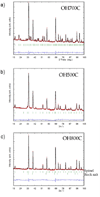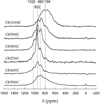Composition-structure relationships in the Li-ion battery electrode material LiNi(0.5)Mn(1.5)O(4)
- PMID: 23002325
- PMCID: PMC3446784
- DOI: 10.1021/cm301148d
Composition-structure relationships in the Li-ion battery electrode material LiNi(0.5)Mn(1.5)O(4)
Abstract
A study of the correlations between the stoichiometry, secondary phases and transition metal ordering of LiNi(0.5)Mn(1.5)O(4) was undertaken by characterizing samples synthesized at different temperatures. Insight into the composition of the samples was obtained by electron microscopy, neutron diffraction and X-ray absorption spectroscopy. In turn, analysis of cationic ordering was performed by combining neutron diffraction with Li MAS NMR spectroscopy. Under the conditions chosen for the synthesis, all samples systematically showed an excess of Mn, which was compensated by the formation of a secondary rock salt phase and not via the creation of oxygen vacancies. Local deviations from the ideal 3:1 Mn:Ni ordering were found, even for samples that show the superlattice ordering by diffraction, with different disordered schemes also being possible. The magnetic behavior of the samples was correlated with the deviations from this ideal ordering arrangement. The in-depth crystal-chemical knowledge generated was employed to evaluate the influence of these parameters on the electrochemical behavior of the materials.
Figures











References
-
- Wagner FT, Lakshmanan B, Mathias MF. J. Phys. Chem. Lett. 2010;1:2204–2219.
-
- Yang Z, Zhang J, Kintner-Meyer MCW, Lu X, Choi D, Lemmon JP, Liu J. Chem. Rev. 2011;111:3577–3613. - PubMed
-
- Armand M, Tarascon JM. Nature. 2008;451:652–657. - PubMed
-
- Amine K, Tukamoto H, Yasuda H, Fujita Y. J. Electrochem. Soc. 1996;143:1607–1613.
-
- Zhong QM, Bonakdarpour A, Zhang MJ, Gao Y, Dahn JR. J. Electrochem. Soc. 1997;144:205–213.
Grants and funding
LinkOut - more resources
Full Text Sources
Other Literature Sources
